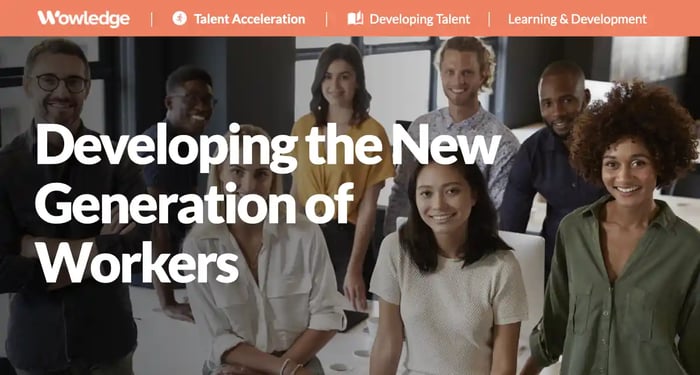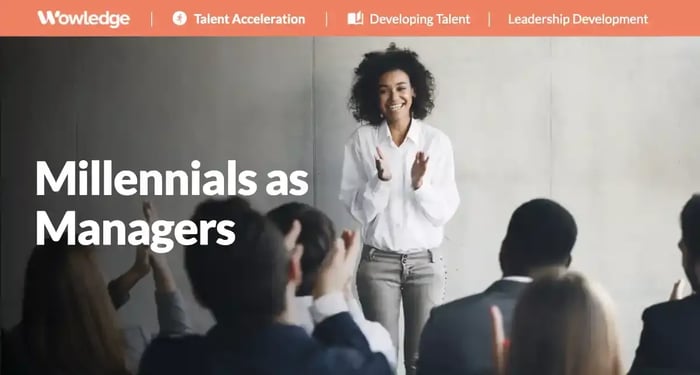In today’s workplace, understanding employees' diverse learning styles and preferences has become increasingly crucial for creating a productive and engaging work environment. This is particularly important given the major changes in the global workforce. With the mass retirement of Baby Boomers, Millennials and Generation Z are now an integral part of the global workforce, accounting for about 46% and 13%, respectively. Together, these younger generations comprise almost 60% of today's workforce. Developing the new generation of workers is a complex yet achievable mission of modern learning and development (L&D) teams.
It is well established that Millennials and Gen Z have high expectations for career development and learning opportunities, significantly influencing their job-changing behavior. Millennials have often been labeled as the "job-hopping" generation since they stay at their jobs for, on average, less than three years. This tenure of 2.8 years is over three times less than the 9.9-year average tenure of workers between 55 and 64, a telling comparison forcing companies to reimagine their retention strategies. At the same time, 53% of Gen Z workers view learning and development as a way to explore career paths at their company, according to the 2024 LinkedIn Learning Report. As they think about mobility and advancement so early in their careers, this points to the importance of reexamining approaches to developing the new generation to drive employee retention.
This shift is not merely about changing jobs for higher pay but is deeply rooted in the desire for meaningful work, personal growth, and the opportunity to make an impact within their roles. Companies that fail to provide continuous learning opportunities, meaningful career advancement paths, and a culture that values employee growth will likely see higher turnover rates among their younger employees. Thus, developing the new generation with tools and methods to address their preferences with advanced learning modalities is a necessity.
Understanding the unique needs and preferences of these dominant workforce segments is beneficial and essential for organizations aiming to enhance their training and development strategies. Developing the new generation of workers by tailoring learning and development initiatives to their unique characteristics can lead to increased employee engagement, improved job satisfaction, and higher retention rates, ultimately contributing to the organization's overall success and competitiveness in our modern marketplace.
Generational overview of characteristics and workplace expectations
Millennials
Born between 1981 and 1996, this generation has witnessed significant technological and social changes. While they are not digital natives, they are highly adaptable to new technologies. They prioritize meaningful experiences over material possessions, translating into their workplace expectations. This generation values work-life balance. They prefer flexible working hours and the opportunity to work remotely.
Millennials are motivated by purposeful work that aligns with their values and appreciate regular and constructive feedback. They are lifelong learners who seek opportunities for personal and professional growth. They thrive in collaborative environments and prefer flat organizational structures over hierarchical ones.
They expect a workplace culture that aligns with their values, offers opportunities for advancement, and fosters a collaborative environment.
Generation Z
Born between 1997 to 2012, is the first generation to grow up entirely in the digital era. They are not only technologically fluent but also highly comfortable with the fast-paced, ever-evolving nature of the digital world. In the workplace, they expect technology to be seamlessly integrated into all aspects of their work.
They prefer autonomy but appreciate clear and regular communication and feedback. Unlike Millennials, Gen Z workers value job security and practical benefits more. This generation tends to establish clear boundaries between work and personal life and is more vocal about mental health. They are more drawn to employers who recognize the importance of mental well-being, offer career advancement and skill development opportunities, and are committed to social and environmental responsibilities.
Overall, Gen Z looks for workplaces that provide stability, embrace innovation, and provide opportunities for personal and professional development in a diverse and inclusive setting.
New generations' learning styles and preferences
Millennials
Millennials have witnessed remarkable shifts in technology, economy, and social norms during their formative years. This exposure to constant change has significantly influenced their approach to learning and development. Developing the new generation calls for learning and development solutions that are:
- Collaborative: Millennials value community, teamwork, and social interaction. They prefer learning in groups or through collaborative projects where they can exchange ideas and learn from their peers' experiences and perspectives.
- Customizable and self-directed: While they enjoy collaboration, Millennials also value autonomy in their learning. They prefer programs that allow them to tailor learning paths according to their individual career goals and interests.
- Experiential: They learn best through doing rather than just listening or reading. Experiential learning opportunities such as simulations, role-playing, and real-world problem-solving activities resonate well with them.
- Feedback-oriented: Regular feedback is crucial for Millennials. They appreciate constructive criticism and guidance that helps them grow professionally. Continuous feedback mechanisms like coaching sessions, performance reviews, and real-time feedback are highly valued.
- Tech-integrated: This generation has experienced the transition from analog to digital. As a result, they are comfortable with a blend of traditional and modern learning tools and appreciate learning resources that incorporate digital media, online platforms, and interactive technologies.
- Purpose-driven: Millennials seek meaning and purpose in their personal and professional lives. They are more engaged in learning that aligns with their personal values and contributes to a greater cause.
Generation Z
Generation Z has distinct learning preferences directly reflect their upbringing in a world dominated by rapid technological advancement, social media, global connectivity, and economic fluctuations. Developing the new generation requires addressing their preferences for:
- Tech-centric learning: Gen Z’s constant connectivity has made them exceptionally proficient with digital tools and platforms, leading to a preference for learning environments that are technology-centric and utilize multimedia, gamification, and interactive elements.
- Visual and interactive learning: Growing up in an age of rapid information exchange and visual media, such as YouTube and Instagram, has shifted their preference for visual learning. They gravitate towards interactive, visually rich educational content like videos, infographics, and interactive apps.
- Self-directed learning: Gen Z is used to find information independently and is self-reliant and resourceful. They often prefer to self-direct their learning experiences, seeking information and skills as needed rather than following a prescribed learning path.
- Emphasis on collaboration and social learning: Despite favoring self-directed learning, Gen Z also values collaborative and social aspects of learning. They appreciate opportunities for group work and peer-to-peer learning facilitated by digital collaboration tools.
- Focus on practical, skill-based learning: Gen Z tends to be practical, having witnessed economic uncertainties. They value skill-based learning that is transparently and directly applicable to their future careers and provides a clear advantage in the job market.
- Shorter attention spans: Many in Gen Z live in an environment of constant information and stimuli, which has led to shorter attention spans. They often prefer bite-sized, concise educational content that is quick to consume and easy to understand, like microlearning.
- The desire for personalization and flexibility: Gen Z is used to personalized experiences through technology and expects a degree of customization in their learning. They appreciate flexible learning systems that adapt to their individual needs, pace, and learning style.

Effective learning strategies for each generation
In the modern workplace, incorporating effective learning strategies that simultaneously resonate with Millennials and Gen Z is crucial for fostering an environment of growth and development. Recognizing the unique characteristics of each generation allows organizations to implement tailored learning approaches, enhance engagement, and facilitate a culture of continuous learning to optimize how L&D approaches developing the new generation.
Strategies for Millennials
- Incorporating group projects and collaborative tasks: Create collaborative learning environments where Millennials can work in teams learning from one another. This will foster a sense of community and shared learning experiences that align with their preference for teamwork and mutual growth.
- Offering a mix of traditional and digital platforms: Utilize a blend of learning methodologies that include both traditional classroom settings and digital platforms. This hybrid approach bridges two worlds: the pre-Internet era into which Millennials were born and the technology-driven world in which they currently live. This combination fosters a dynamic and flexible learning experience.
- Providing mentorship programs and leadership development opportunities: Implement structured mentorship programs and leadership training initiatives. These opportunities resonate with Millennials' desire for personal and professional development and social contact, while offering guidance and pathways to leadership roles within the organization.
Strategies for Gen Z
- Implementing more autonomous and customizable learning modules: Design learning programs that allow Gen Z to personalize their learning paths and proceed at their own pace. This autonomy supports their preference for self-directed learning and the ability to tailor learning experiences to their current and future needs.
- Leveraging advanced technologies: Integrate cutting-edge technologies such as Augmented Reality (AR), Virtual Reality (VR), gamified learning experiences, and mobile platforms. These technologies appeal to Gen Z’s tech-savvy nature, offering more engaging, interactive experiences that help them better understand and retain knowledge.
- Offering microlearning and bite-sized learning experiences: Provide concise, easily digestible learning modules that cater to Gen Z’s preference for quick and focused content, as evidenced by their heavy consumption of short-form video content. Microlearning allows them to absorb information and apply it immediately and efficiently.
Blending Millennial and Gen Z preferences in the workplace
Creating a learning environment that successfully integrates the preferences of both Millennials and Gen Z requires a nuanced understanding of their distinct learning styles and a commitment to personalization. As challenging as it may seem, this integration enhances the learning experience and reflects a company's dedication to its employees' development.
Creating a cohesive learning environment that addresses the needs of both generations requires a blend of strategies for developing the new generation:
1. Personalization in learning and development programs
Tailor learning experiences to accommodate each generation's diverse preferences and learning styles. This could involve offering a range of options that allow employees to choose how they engage with learning materials, whether through digital platforms, hands-on projects, or traditional classroom settings.
2. Gamification and competitive elements
Introduce game-like elements and competition into learning activities to increase engagement and motivation. Leaderboards, badges, and rewards can cater to the competitive spirit of both generations while making learning more fun and memorable.
3. Real-world applications
Ensure learning activities are grounded in real-world applications and scenarios. This approach resonates with both generations' desire for practical, applicable knowledge and aligns with Gen Z's focus on skill-based learning.
4. Collaborative projects and peer learning
Facilitate group work and peer-to-peer learning opportunities. This leverages Millennials' preference for teamwork and introduces Gen Z to collaborative skills essential for the workplace while respecting their independence.
5. Flexibility and autonomy
Offer flexible learning schedules and the autonomy to choose learning modules or projects. This flexibility is crucial for meeting Millennials' work-life balance needs and Gen Z's self-directed learning preference.
6. Balancing technology and human interactions
Invest in technology such as online collaborative tools, or platforms that support AR/VR experiences. This creates an engaging, tech-forward environment that appeals to both generations' digital competencies. Leverage intelligent technologies that recommend learning paths based on the individual’s skills and interests. Mix it with mentorship programs or team-building activities to foster a sense of belonging and community among employees.
Challenges and considerations
While integrating the learning preferences of Millennials and Gen Z presents an opportunity for organizational growth, it also comes with challenges. Meeting the diverse needs of these two requires a flexible and adaptive approach to developing the new generation. However, if learning strategies are implemented effectively, companies can not only leverage the unique strengths of each generation but also get ahead of the curve in fostering an innovative workplace culture.
Personalization at scale
Both generations value personalized learning experiences, but large-scale implementation can be logistically challenging and resource-intensive. Developing a learning program that feels personal to hundreds or thousands of employees requires complex and advanced learning management systems and an increased investment in content development and maintenance.
Balancing asynchronous and synchronous learning
Millennials tend to appreciate collaborative, synchronous learning opportunities, whereas Gen Z often prefers the autonomy of asynchronous learning. Creating a strategy that effectively incorporates both can be complex, requiring careful scheduling and the development of varied content that is engaging across different formats.
Skill-based learning vs. career development
Gen Z focuses on acquiring practical, job-specific skills, while Millennials often seek broader career development and leadership training opportunities. Developing programs that cater to both requires thorough needs assessments involving surveys, focus groups, and one-on-one employee interviews. This will help to create relevant and targeted programs.
Feedback frequency and format
Millennials want regular feedback, and Gen Z desires immediate, digital feedback. Implementing a continuous, real-time feedback mechanism that satisfies both generations' expectations without placing unnecessary burdens on managers is a logistical challenge. Besides traditional performance review systems, companies can implement a digital feedback platform that allows for real-time feedback, questions, and acknowledgments. They can also establish structured peer review systems or feedback loops within teams, reducing the burden on managers.
Maintaining engagement and motivation
Given diverse learning preferences, maintaining high levels of engagement and motivation across both generations requires creative thinking and experimentation. This could mean leveraging gamification for one segment while offering scenario-based learning for another, all within the same program framework.
Resource allocation
Balancing budget constraints with the need to invest in new technologies, content, and training methodologies to suit both generations is a constant challenge. Managers must make strategic decisions about where to allocate resources for the maximum impact on learning outcomes. When companies attempt to establish a dynamic learning environment that accommodates both generations, their efforts can result in different levels of success. The key to navigating these outcomes is fostering a culture of continuous feedback, adaptability, and improvement. Companies can ensure their approaches remain effective and relevant by establishing mechanisms that allow learning strategies to evolve based on employee input. Companies must encourage adaptability among learners and educators to further meet the evolving needs of employees.
These combined efforts enhance employee satisfaction and development and strategically position companies for greater success in a competitive marketplace.
Final thoughts
Understanding and integrating the learning styles and preferences of Millennials and Generation Z into the workplace is critical for modern organizations. The disproportionate influence that skills and career development have on employee retention, along with these employees’ lower tenure profiles, only drives the higher importance of developing the new generation. As these younger generations become the largest portion of the workforce, their unique needs and expectations present challenges and opportunities for learning and development strategies. Companies can build a dynamic, inclusive, and forward-thinking workplace by embracing the new workforce landscape. These efforts are not just beneficial for employee satisfaction and development. They are essential for positioning companies at the forefront of innovation and success in the modern marketplace.
Relevant Practices & Tools
Tailoring Learning Offerings to Critical Workforce Segments for Increased Impact on the Highest Value Roles. >
Critical Workforce Segmentation is the process by which the roles that have a disproportionate impact on the strategic goals of the organization are identified... more »
Creating Informal Learning and Experiential Development Opportunities for Cost-effective Delivery. >
Informal learning is broadly defined as any learning activity that is not learned in a formal class, has no set goals or objectives, and focuses on the enhancement or addition of knowledge... more »
Developing Leaders Across Multiple Levels of Management. >
Advanced leadership development is designed to not only develop current executives, but "leaders" in all levels of the organization. While development programs and offerings will differ... more »
Creating Group Coaching and Mentoring Programs to Broaden and Syndicate the Potential for Impact. >
As a coaching and mentoring culture progresses, its effect is felt throughout the organization. The key at this level is to syndicate the use of coaching and mentoring deeper into the ranks... more »
Creating a Culture of Internal Mobility that Supports Employee Development and Retention. >
Creating a culture of mobility requires management to accept that the benefits of movement (promotions and transfers) far outweigh the costs of replacing workers in their teams... more »
About Wowledge
Wowledge is the expert-driven platform for lean teams building strategic HR programs. Members enjoy access to up-to-date best practices, step-by-step guides, tools, templates, and insights to accelerate the design and implementation of all key HR programs and processes.
Since each organization has unique characteristics, needs, and aspirations, Wowledge's practices are developed utilizing an exclusive stage-based approach – from Core to Advanced to Emerging – that reflects distinct levels of sophistication to meet our members where they are.
Build strategic HR programs with refreshingly easy-to-follow best practices.
Get started for FREE! Learn more.










